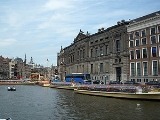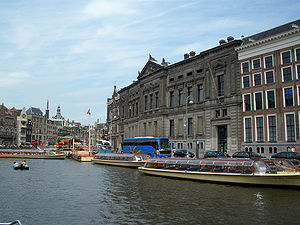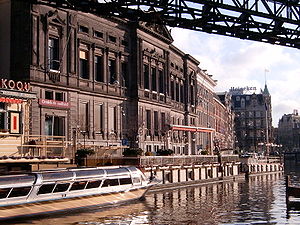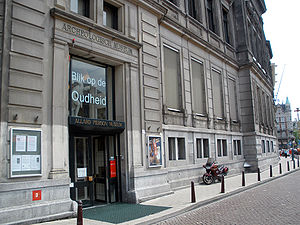
Allard Pierson Museum
Encyclopedia



Amsterdam
Amsterdam is the largest city and the capital of the Netherlands. The current position of Amsterdam as capital city of the Kingdom of the Netherlands is governed by the constitution of August 24, 1815 and its successors. Amsterdam has a population of 783,364 within city limits, an urban population...
, the Netherlands
Netherlands
The Netherlands is a constituent country of the Kingdom of the Netherlands, located mainly in North-West Europe and with several islands in the Caribbean. Mainland Netherlands borders the North Sea to the north and west, Belgium to the south, and Germany to the east, and shares maritime borders...
. Artifacts from the ancient civilizations of ancient Egypt
Ancient Egypt
Ancient Egypt was an ancient civilization of Northeastern Africa, concentrated along the lower reaches of the Nile River in what is now the modern country of Egypt. Egyptian civilization coalesced around 3150 BC with the political unification of Upper and Lower Egypt under the first pharaoh...
, the Near East
Ancient Near East
The ancient Near East was the home of early civilizations within a region roughly corresponding to the modern Middle East: Mesopotamia , ancient Egypt, ancient Iran The ancient Near East was the home of early civilizations within a region roughly corresponding to the modern Middle East: Mesopotamia...
, the Greek World
Ancient Greece
Ancient Greece is a civilization belonging to a period of Greek history that lasted from the Archaic period of the 8th to 6th centuries BC to the end of antiquity. Immediately following this period was the beginning of the Early Middle Ages and the Byzantine era. Included in Ancient Greece is the...
, Etruria
Etruria
Etruria—usually referred to in Greek and Latin source texts as Tyrrhenia—was a region of Central Italy, an area that covered part of what now are Tuscany, Latium, Emilia-Romagna, and Umbria. A particularly noteworthy work dealing with Etruscan locations is D. H...
, and the Roman Empire
Roman Empire
The Roman Empire was the post-Republican period of the ancient Roman civilization, characterised by an autocratic form of government and large territorial holdings in Europe and around the Mediterranean....
are curated and exhibited in this museum.
Allard Pierson
The name of the Allard Pierson Museum derives from the first professor of classical archaeology at the University of Amsterdam, Allard PiersonAllard Pierson
Allard Pierson was a Dutch theologian, historian, and art historian. He was a leading proponent of radical criticism in the Netherlands.-Life:Pierson's father was a merchant in Amsterdam, his mother an author of pietist works...
(1831-1896). This former clergyman was invited in 1877 to occupy the chair of Aesthetics, Art History, and Modern Languages at the newly founded university. His passion for antiquity
Ancient history
Ancient history is the study of the written past from the beginning of recorded human history to the Early Middle Ages. The span of recorded history is roughly 5,000 years, with Cuneiform script, the oldest discovered form of coherent writing, from the protoliterate period around the 30th century BC...
, fuelled by his travels to the Mediterranean area, led to his assembling a collection of plaster casts from 1877 to 1895.
Founding of the museum
The second professor of archeology at the University of Amsterdam, Jan Six, had a large personal collection of books and antique objects. At his death in 1926, the university had interest in acquiring his collection. In 1932, Pierson's son Jan Lodewijk established the Allard Pierson Foundation in order to make the antiquities collection available for research and teaching. The collection was brought to a building on the Weesperzijde in Amsterdam, with the top floor serving as a museum.The collection grew due to purchases, gifts, and loans of artifacts and documents. On 12 November 1934, the Allard Pierson Museum was officially opened in a building at Sarphatistraat 129-131 (corner of the Roeterstraat). The museum would eventually out grow it's building.
The building
A new building became available when the Nederlandse BankDe Nederlandsche Bank
De Nederlandsche Bank is the central bank of the Netherlands. It is part of the European System of Central Banks .-History:...
vacated their office at the Oude Turfmarkt in 1976. H.R.H. Princess Beatrix
Beatrix of the Netherlands
Beatrix is the Queen regnant of the Kingdom of the Netherlands comprising the Netherlands, Curaçao, Sint Maarten, and Aruba. She is the first daughter of Queen Juliana of the Netherlands and Prince Bernhard of Lippe-Biesterfeld. She studied law at Leiden University...
attended the re-opening of the museum on 6 October 1976.
The collection
The museum has collections related to the ancient civilizations of ancient EgyptAncient Egypt
Ancient Egypt was an ancient civilization of Northeastern Africa, concentrated along the lower reaches of the Nile River in what is now the modern country of Egypt. Egyptian civilization coalesced around 3150 BC with the political unification of Upper and Lower Egypt under the first pharaoh...
, the Near East
Ancient Near East
The ancient Near East was the home of early civilizations within a region roughly corresponding to the modern Middle East: Mesopotamia , ancient Egypt, ancient Iran The ancient Near East was the home of early civilizations within a region roughly corresponding to the modern Middle East: Mesopotamia...
, the Greek World
Ancient Greece
Ancient Greece is a civilization belonging to a period of Greek history that lasted from the Archaic period of the 8th to 6th centuries BC to the end of antiquity. Immediately following this period was the beginning of the Early Middle Ages and the Byzantine era. Included in Ancient Greece is the...
, Etruria
Etruria
Etruria—usually referred to in Greek and Latin source texts as Tyrrhenia—was a region of Central Italy, an area that covered part of what now are Tuscany, Latium, Emilia-Romagna, and Umbria. A particularly noteworthy work dealing with Etruscan locations is D. H...
, and the Roman Empire
Roman Empire
The Roman Empire was the post-Republican period of the ancient Roman civilization, characterised by an autocratic form of government and large territorial holdings in Europe and around the Mediterranean....
. The collections include art objects and utensils dating from 4000 BC to 500 AD. There are also scale models of ancient temples and buildings. In the Ancient Egypt exhibition there is a room dedicated to death, with mummies, sarcophagi, and a film showing the process of mummification. The plaster-cast attic, to be visited only with a guided tour, shows copies of Roman and Greek statues.
The museum's Greek pottery collection features examples of black-figure
Black-figure pottery
Black-figure pottery painting, also known as the black-figure style or black-figure ceramic is one of the most modern styles for adorning antique Greek vases. It was especially common between the 7th and 5th centuries BC, although there are specimens dating as late as the 2nd century BC...
and red-figure pottery
Red-figure pottery
Red-figure vase painting is one of the most important styles of figural Greek vase painting. It developed in Athens around 530 BC and remained in use until the late 3rd century BC. It replaced the previously dominant style of Black-figure vase painting within a few decades...
produced in the fifth and sixth centuries BC. A collection of Roman sarcophagi are also on display, including a rare wooden coffin from around 150 AD that is carved partly in the shape of the man within it.

